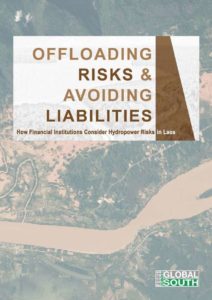06/03/2019
Under: Laos, Mekong Region, Publications, Trade and Investment
The collapse of Saddle Dam D of the Xe-Pian Xe-Namnoy Dam project in Southern Laos in July 2018 directed a great deal of public attention to the risks and dangers associated with dams. Initial evidence suggests willful misconduct on part of one of the project developers. An important question though is whether the country has in place the necessary mechanisms for risk assessment, due diligence, quality monitoring and accountability, to avoid similar dam-related disasters in the future.
This paper examines how financial institutions identify, evaluate, address and manage hydropower risks. The paper finds that the likely profitability of dams as a financial asset and their energy markets has made dam building highly attractive. However, risk assessments carried out by financial institutions often fail to provide an accurate picture of the full risks and costs involved in dam building, in part because the investor will lose upfront project costs if the dam is not approved and, because there is no effective independent regulatory system in place in Laos to ensure accurate project planning and accountability from investors. Thus, many longer-term risks are simply transferred onto the public.






